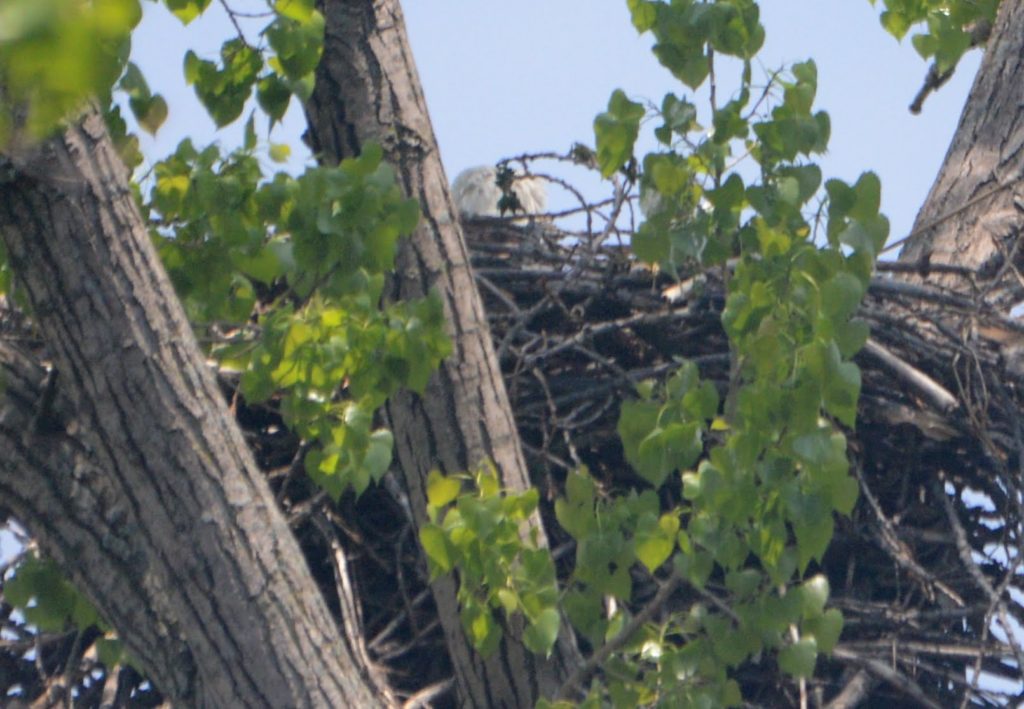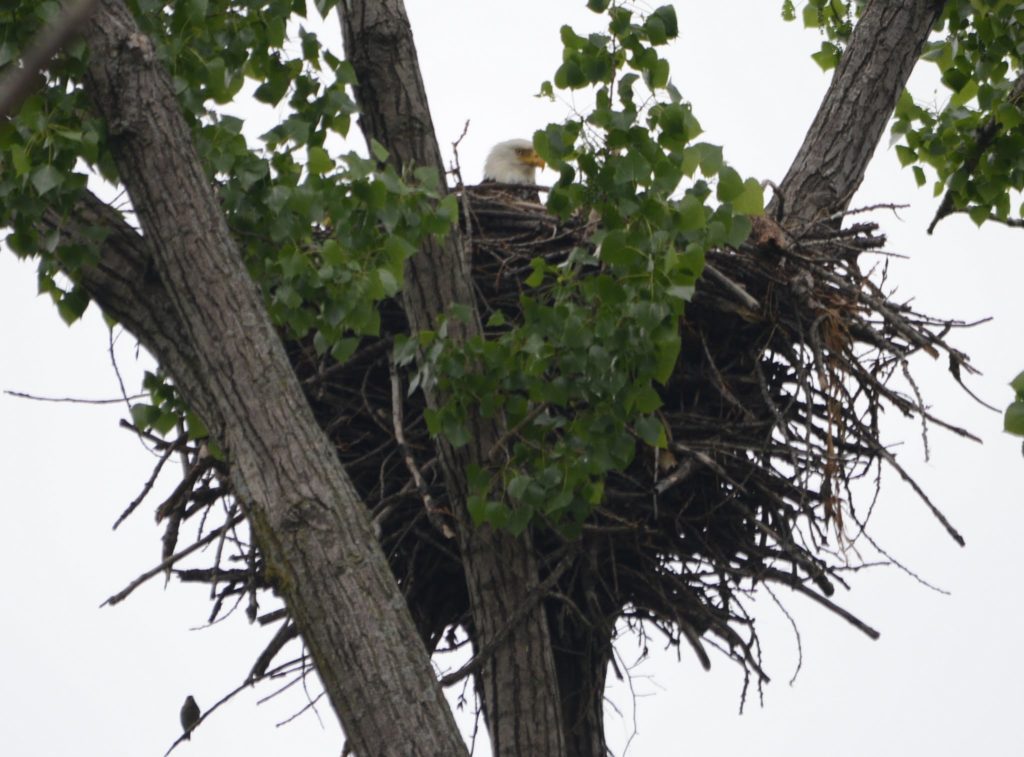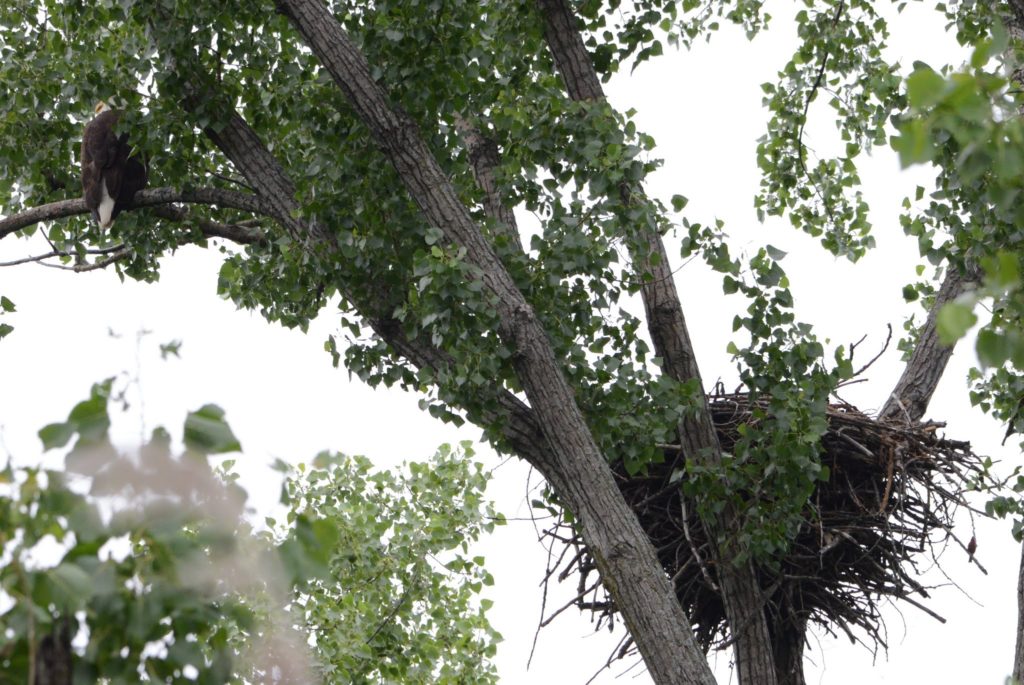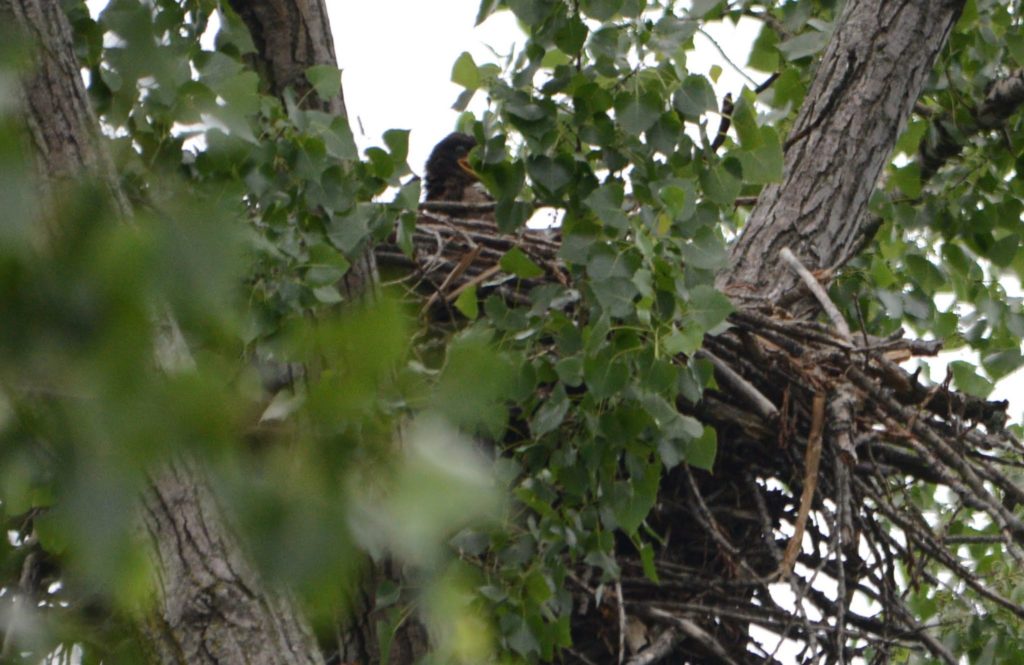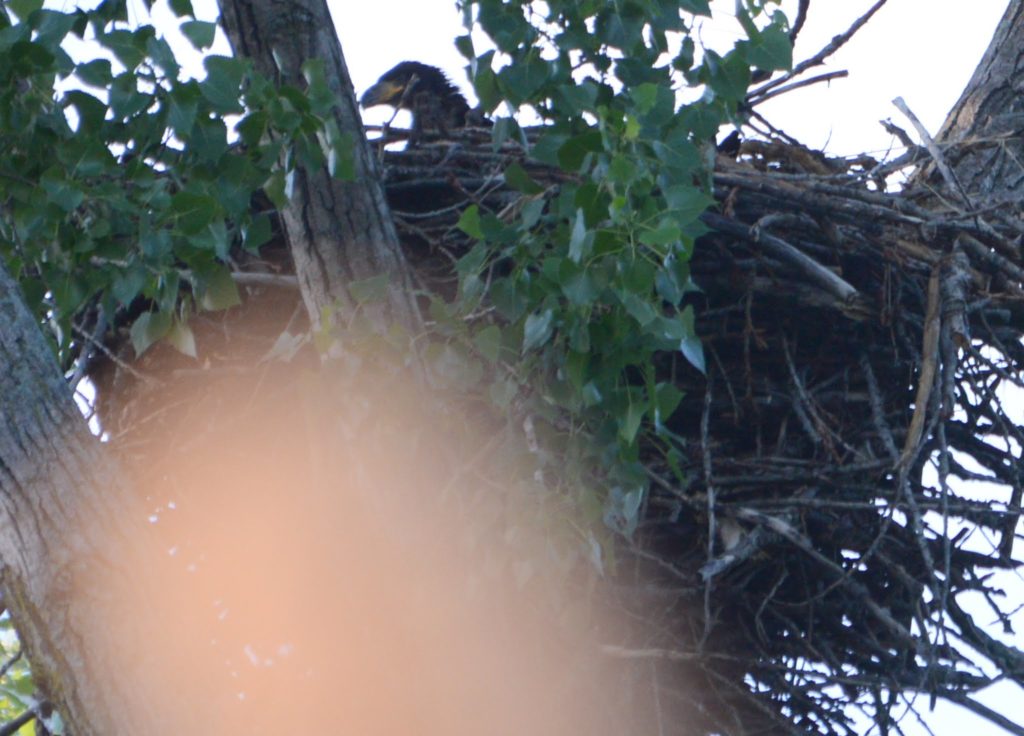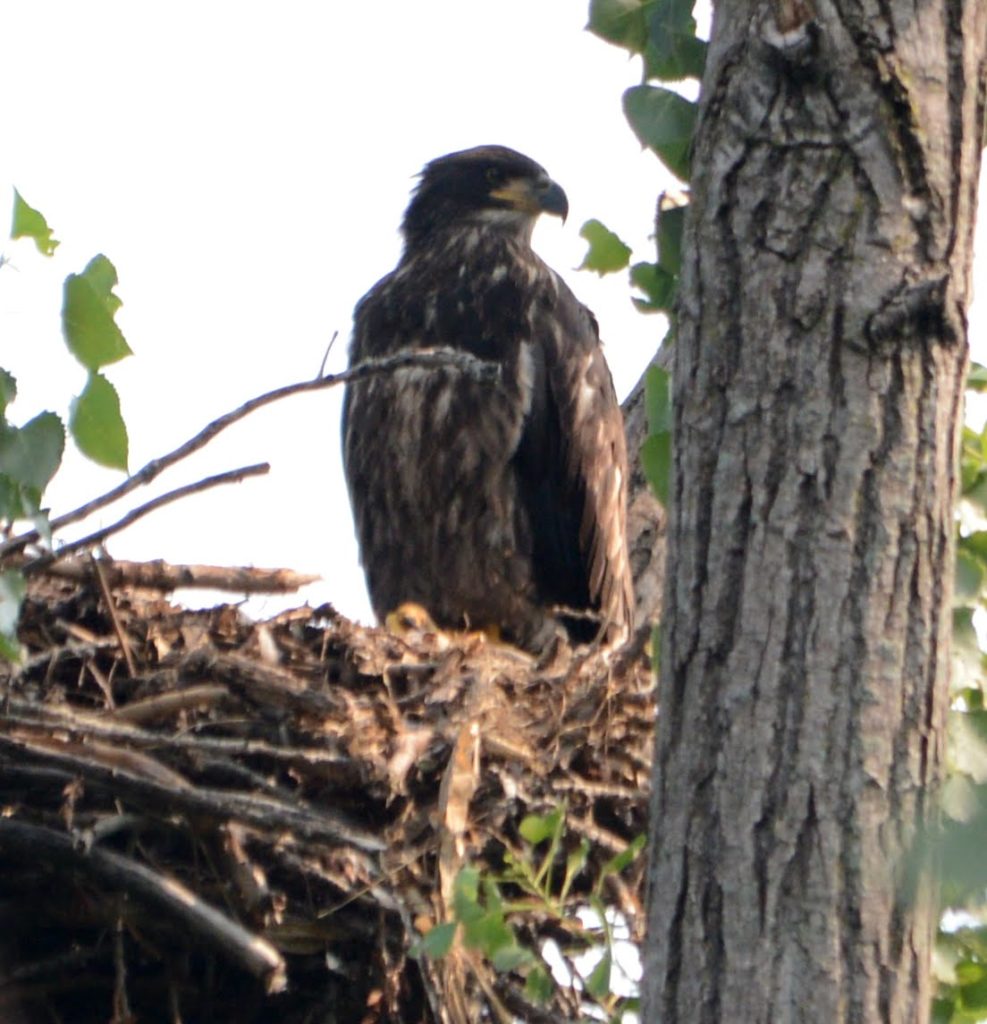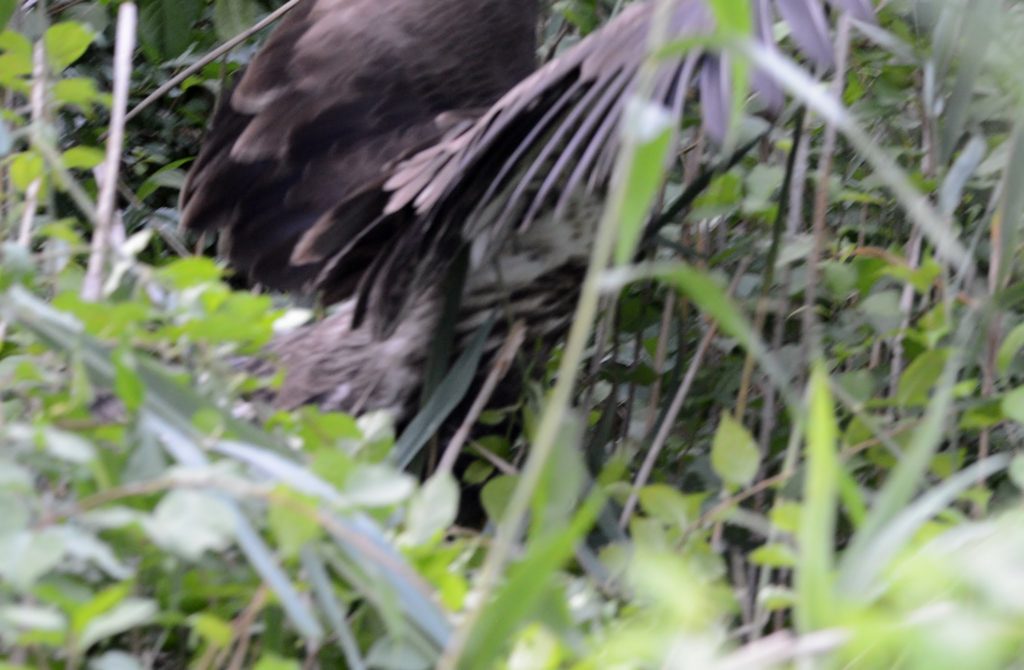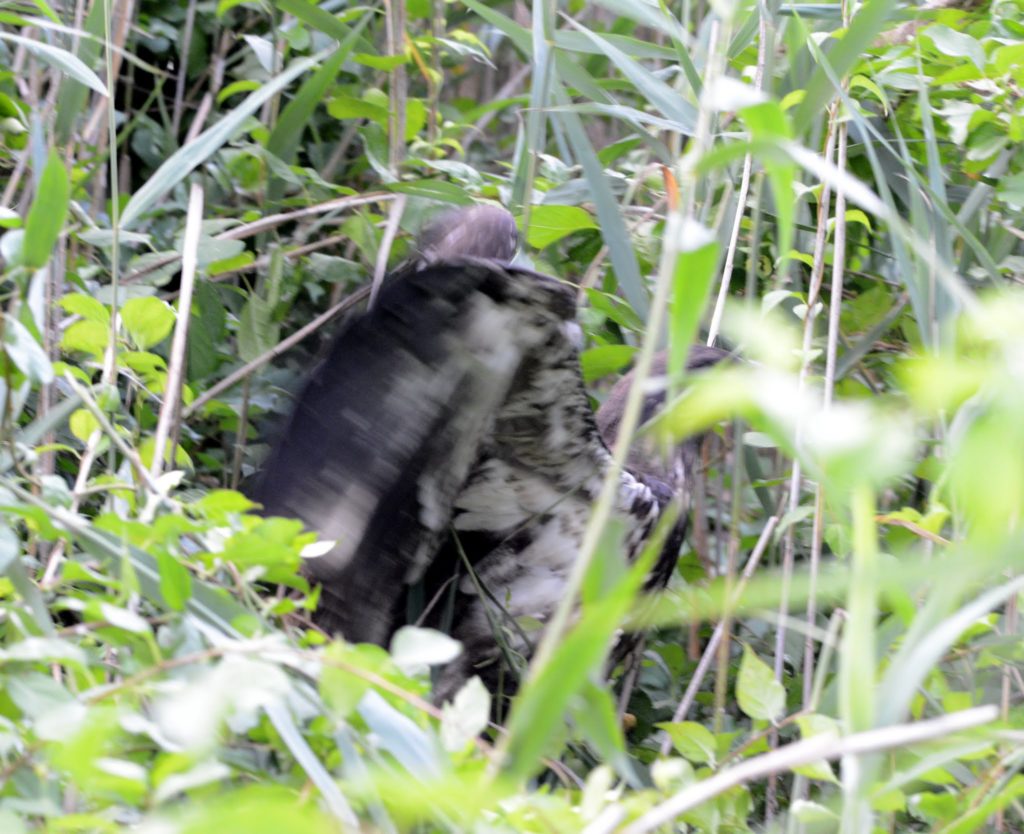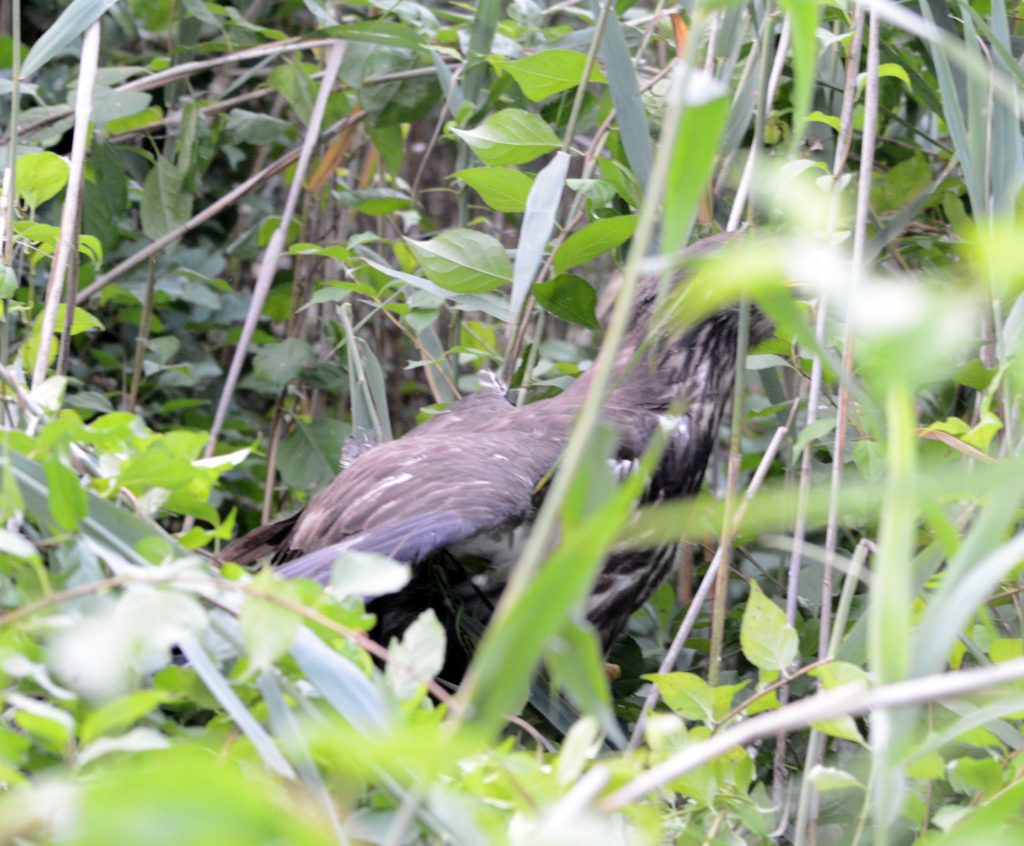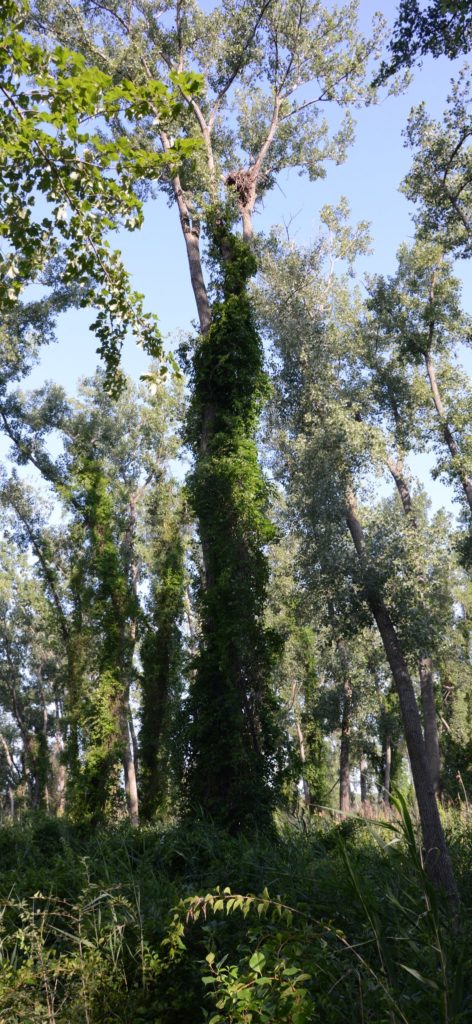
July 2015.
For many years Robin and I have been paddling on the Hudson near our house in Germantown. There are half a dozen standard destinations – the marsh just north of Lasher Park, the 4 mile round-trip to Roeliff Jansen kill, or the 9 mile round-trip to the RamsHorn-Livingston sanctuary near Catskill. There’s the very quiet and shallow water of Inbocht Bay in back of Marsh Island, and there’s Duck Cove, where you can get trapped on the uphill side of the seawall when the tide falls. We’ve visited all these many times.
One of our most common trips was to visit the nearby bald eagle nest. The nest was, like all eagle nests, impressively large, and surprisingly high, resting in a fork in the tallest tree along the riverbank. Eagles build to last, and a nest may be used for many seasons. It would be common to see an eagle nearby, but I don’t recall ever seeing one actually in the nest. It was obvious that this nest was known to the NY Department of Environmental Conservation (DEC) because the tree trunk had a slippery belt to prevent raccoons from climbing the tree, and there was a DEC sign nearby with a few rules and regulations.
The back story is that, yes, the lure of visiting an eagle nest is obvious, undeniable. But I also love to take pictures and I almost always have a camera with me when I kayak. So keeping track of where the eagles hang out along the Hudson, that’s been important to me for a long time. Here’s a photo from this spring, an eagle in a tree overlooking Duck Cove, about a mile from our house:
In the spring of (perhaps) 2012 Robin and I paddled over to the nest and found that it had vanished. The tree was gone, even the earth where the tree had stood was gone, scoured out by the river. Other nearby trees had also blown over. It was almost as if we were in the wrong place. What had happened is that a no-name spring windstorm had blown the nest tree into the river, and high tides had swept it away, root ball, branches, nest, and all.
Later that year Robin and I noticed a new eagle nest nearby. So the new nest became one of our paddling destinations, and it was common to see eagles on high branches nearby. This spring in early May I was talking to Tom Lake of the NY DEC about this new nest. Tom runs the Hudson River Almanac, which is a weekly newsletter with brief articles about things of interest near the Hudson, from NY harbor all the way into the heart of the Adirondacks at the Hudson’s source, Lake Tear of the Clouds, more than 4000 feet above sea level. Like hundreds of others, I’m an occasional contributor to the Almanac.
In talking to Tom about this new nest, he at first thought I was referring to the nearby original nest, which he told me was designated NY28, meaning the 28th nest cataloged in NY since the eagles started to return in the 1990s. The reemergence of eagles in the Hudson valley, the Mohawk valley, along the Delaware, and elsewhere in the region is one of our great environmental successes. The DEC has been keeping track, and NY28 was early in the story.
But now, it was time for a new chapter. This new nest had already been named NY203 and Tom suggested that I might want to keep an eye on it. Wow, I must admit, it felt pretty cool. My brother-in-law Udo suggested that I put “NY203” on my license plate. NY203 became a shorthand in our house that somehow tied together ‘dad’, ‘eccentric’, ‘BIRDS!’ and whatever else might fit.
The most famous eagle nest in the Hudson Valley is NY62. It’s in the vicinity of Poughkeepsie, and it’s situated in a way that it’s easy to get to, and easy for people to observe without disturbing the eagles. There are usually one or two entries on NY62 in the Almanac each week in the spring and summer. Almanac readers get to know the NY62 nestlings, hear about their first days, mourn when something goes wrong, and celebrate the milestones. A lot of attention is paid to the fish that mom and dad deliver several times a day. And even more attention is paid to the antics of the juveniles as they flex their wings on branches near the nest, working up the nerve for their first flight. For a certain type of person, NY62 is high drama.
The allure of NY203 is almost the opposite of NY62. Unlike ’62, NY203 is hard to visit. It’s not near any road, so you have to go by water. And it’s very shallow nearby, so most motorized boats can’t get close, except briefly at high tide. It’s not even easy in a kayak, which can get stuck on nearby mudflats at low tide. And it’s not easily visible from a distance, because it’s set back from the shoreline and well hidden by surrounding trees.
In early May I paddled to NY203 a couple of times, but nothing much was happening. Finally, on May 8 I paddled over and saw an adult on a nearby branch. And it was almost like he was posing, because by paddling to the right spot, I could line up a picture of the adult with the nest in the background.
The individual picture of the eagle is a little soft because I’d splashed a bit of water onto the front of my lens. Remember, these photos were taken from a kayak, moving in the wind and waves. None were taken from shore. It’s not easy to handle a large bulky camera and a 500mm lens while sitting in a kayak. Hard to keep it clean, hard to hold it still, and hard to frame the shot because if you’re holding the camera, you’re not holding the paddle, which means the tide and wind are moving the boat.
Just for my own ‘records’, I took a few closeup photos of the nest. Well, as close as I could manage from about 150′ away. When I got home and looked at the photos on my computer, I quickly realized that there was something going on.
The white orb just visible above the nest rim is the back of the head of (probably) mother eagle. And sitting low in the nest, in the middle of the day when she could be flying up and down the river, being in the nest at that time means she is probably minding the eggs. Tom and I exchanged several emails about this; what he ended up placing in the May 15 issue of the Hudson River Almanac is this:
5/8 - Greene County: While paddling my kayak on the river today, I visited an eagle nest (NY203) from off shore at a respectable distance. An adult (looked like the male) was perched in a tree just in front of the nest and another adult (the female?) was sitting in the nest.
- Kaare Christian
That was the first public mention of NY203.
I tried to paddle to the nest on May 20th, but was rebuffed by high winds. I tried again on the 21st, and wrote to Tom
Today I went at almost low tide, which is not ideal. But one bird was on the nest. And for the first time, I could see the eagle in the nest with my naked eye. I only spent a couple minutes there, just time enough to take 4 pictures, of which this is the only one showing most of the head.
Tom’s summary of our email back and forth was the 2nd mention of NY203 in the Almanac.
5/21 - Greene County: I visited the vicinity of eagle nest NY203 in my kayak today at almost low tide, which was not ideal. But I could see, despite looking through a maze of cottonwood leaves, an adult sitting on the nest. - Kaare Christian
My team, the mom and pop of NY203, were obviously doing well. But they were also many weeks behind the superstars of NY62. In the same May 29 issue of the Almanac, there were two reports on NY62, including this:
5/19 - Town of Poughkeepsie: We spent some time watching eagle nest NY62 today. We couldn't believe how big “Destiny,” the single nestling, has gotten in just the last week – at least half the size of Mom and Dad. - Debbie Quick, Bob Rightmyer
NY203: still sitting on eggs. NY62: “Destiny” had grown, thanks to all those raw fish deliveries, to half the size of his or her parents.
A week later, May 29, I visited NY203 again, and it looked like progress.
Seeing an adult on the rim could indicate fledglings were present in the nest. I didn’t see them and couldn’t know for sure, but in private email Tom was encouraging. He advised me to wait just a bit longer and I would see fledglings. But in the Almanac, he crafted a more neutral message:
5/29 - Greene County: Just before sunset, paddling my kayak, I visited the bald eagle nest (NY203) not far from where I live. I watched from a distance, still trying to determine if there had been a hatch and if there were nestlings. The tide was extremely low. One adult was sitting on the rim of the nest, easily visible, but still no sign of fledglings. - Kaare Christian
My next chance for a visit was June 14th. One of the adults was on a branch near the nest, which was nice to see, and a good sign.
But again, no nestlings visible in the nest from my kayak. Nearby adult: good; nothing else to see: frustrating. Again I took a few shots of the nest, just as a personal record. And again, more careful study on a larger screen, revealed what I’d been waiting for.
It’s not a great photo, but it does show a nestling, at last!
6/15 - Greene County: This morning was my first visit in eighteen days to check on the bald eagle nest (NY203) near where I live. Both adults were perched in a dead tree near the nest, but I could discern no activity in the nest itself. I returned later in the day just as daylight was fading and finally saw a very young-looking nestling looking out of the nest. I could just see the little brown head between the cottonwood leaves. - Kaare Christian
I returned two days later in the morning, and the two adults were in a nearby dead tree. I took over a dozen photos of the nest, but no sign of a nestling, even when I looked closely on my large home monitor. Disappointed but not discouraged, I returned in the late afternoon and this time the nestling was easy to see, even just sitting in my kayak.
The brown blur is out of focus common reed (Phragmites australis) which, growing rapidly to a height of twelve or more feet, has made it increasingly hard to photograph the nest from close to shore. In early May I could photograph the nest by finding a break in the tree limbs and leaves; now in mid June I needed to find a break in the common reed that also coincides with a break in the tree limbs and leaves.
When I paddled over on July 6, the nestling looked large and healthy.
7/6 - Greene County: I paddled my kayak over to check on progress at bald eagle nest NY203. Mom and Dad were perched in a nearby tree and their lone nestling was sitting on the rim of the nest. It was good to see that everyone was doing well. - Kaare Christian
Meanwhile, about 30 miles south at NY62, “Destiny” had been flying for two weeks. She merited seven separate mentions in that week’s Almanac, winning praise for her (his?) increasing flying ability, increasing independence, and still healthy appetite.
At NY203, the next step should have been seeing the nestling take flight. On July 15th I paddled to the nest, hoping to see the nestling on a nearby branch, perhaps steeling herself for her first flight. Or perhaps standing confident nearby, having just returned from a flight. But instead, nothing. I went over twice that day, once in the morning and once near dusk. On both visits, I didn’t see an adult nearby, and nothing was in the nest. This just seemed so wrong, to get so far, to see the eaglet make so much progress, and then nothing.
As I started to paddle back to my house, I became convinced that something was very wrong, and that I had to do more, to look harder. With a knot in my gut, I decided to go ashore and see what I could find at the base of the nest tree. There is a dense row of common reeds guarding the nearest approaches to the nest tree area, but down the shore about 50 yards there’s a break in the common reeds. I beached the kayak, setting foot on land near the nest for the first time. The ground is low and soggy, overgrown, full of prickly bramble, teeming with insects, crisscrossed with deadfall, and littered with refuse from flooding. And it was quickly getting dark. The last fifty feet were the hardest. I was wearing bathing trunks and a T-shirt, trying not to drop the camera, trying to see where I was placing each sandled foot. (Obviously, i was not dressed for bushwhacking.) The bramble was chest high, and I did my best to high-step onto it, trying to be as on top as possible to bend it down.
I had just about reached the nest tree when I heard something large trying to move away. It was the baby eagle, tangled in the brush, trying to flap and hop, but pinned in place by bramble and brush, unable to move, unsure of whether to look at me or try to look away. I’d paddled to the nest area with my telephoto lens, anticipating a photo from a hundred feet or more, but now I was just six or eight feet away. And I was also aware that my presence was adding stress to the situation, and could even be discouraging the parents, if they were nearby, from helping or feeding. I held the camera above my head, took three quick shots (4 seconds elapsed), and then backed away.
When I got home I immediately emailed Tom for help:
Tom, the nestling is on the ground, near the base of the nest. It's moving, I think both wings move, but obviously there is a serious problem.
That evening Tom reached out to various colleagues at the DEC for advice. I was obviously upset, but Tom reassured me that these birds are resourceful, and that they have ways of surviving such problems. And from his impromptu eagle advice group, the consensus opinion was to discretely take a fresh look first thing in the morning.
When I paddled into the area the next morning, the first thing I noticed was that nothing was visible in the nest, but both parents were in trees nearby, calmly looking out at the Hudson. Neither parent flew off when I stepped ashore for the second time, which I interpreted as a good sign, indicating they weren’t in distress. The light was much stronger than the previous twilight, and I’d been there once already, which made it easy to retrace my steps to the nest tree. As I wrote to Tom afterwards:
At the base of the nest tree, I was surprised by how tramped down my trail was. I didn't purposely 'blaze' a trail, but perhaps it proved useful. In the light of day (it was twilight yesterday when I was there) it was also obvious that there were multiple areas where the brush and plants had been stomped down, in areas where I hadn't been, so presumably by the nestling. Several of these were dead end 'trails' leading away from the nest tree.
The nestling wasn’t there, which was probably the best that could be expected. What I think happened is that the nestling hopped and struggled down the path I had trampled, managing to get to a more open area where she could get up onto some branches, and eventually make her way to safety. I didn’t see the nestling anywhere that morning, but I’m confident she survived and is OK.
The morning visit to the nest tree from the land side gave me an opportunity to see the nest from a new vantage. I didn’t want to linger, because I didn’t want to stress the adults, but I had come with an appropriate lens, a change from the previous night, and I took a few shots of the nest tree.
The bushy leaves on the trunk are tree vine and the nest tree is a cottonwood, both of which are very common in the Hudson valley.



